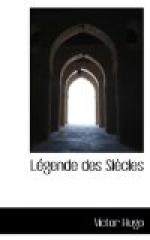Henoch, English Enoch, Cain’s son.
Tubalcain, English Tubal-cain, the son of Lamech and his wife Zillah. He was ’the forger of every cutting instrument of brass and iron.’
Seth was the third son of Adam and Eve, and
Enos was the son of Seth.
PUISSANCE EGALE BONTE.
Iblis, one of the names used in the Koran for the Spirit of Evil. He was a spirit who refused to prostrate himself before Adam at the command of the Almighty, and was therefore expelled from Eden. Instead of being immediately destroyed, however, he was given a respite till the Day of Judgement. The word is derived from the Arabic balas, wicked.
Another tradition, not found in the Koran, is that Iblis was a warrior angel whom the Almighty sent to exterminate the Djinns, the beings, half men, half angels, who inhabited the country of the Genii. Instead of performing this command, the spirit rebelled and was cast down into hell. It is hardly necessary to add that Hugo’s story is of his own invention.
Bonte (see heading), one of Hugo’s favourite words for expressing the moral attributes of the Almighty power. The theme that God is goodness, which is more than justice, is developed in Dieu: La Lumiere.
La justice, c’est vous, l’humanite;
mais Dieu
Est la bonte.
Compare also the concluding lines of Le Crapaud.
The word has no exact equivalent in English. It comprehends kindness, tenderness, and gentleness.
It may be interesting to note that Hugo was fond of comparing an object composed of a centre and rays to a spider. Edmond Huguet (Les Sens de la Forme dans les Metaphores de Victor Hugo) gives the following examples:
’De la hauteur ou je suis,
la rade pleine de nacelles (a
quatre rames) figure une mare couverte d’araignees
d’eau.’
(Alpes
et Pyrenees.)
’Nous estimons une araignee chose hideuse et nous sommes ravis de retrouver sa toile en rosace sur les facades des cathedrales, et son corps et ses pattes en clef de voute dans les chapelles.’ (France et Belgique.)
’Les lanternes de ce temps-la ressemblaient a de grosses
etoiles rouges pendues a des cordes, et jetaient sur le
pave une ombre qui avait la forme d’une grande araignee.’
(Les Miserables.)
Rostabat prend pour fronde, ayant
Roland pour cible,
Un noir grappin qui semble une araignee horrible.
(La Legende des Siecles, Le Petit
Roi de Galice.)
’Trois ou quatre larges araignees
de pluie s’ecraserent
autour de lui sur la roche.’ (Les Travailleurs
de la Mer.)
Hugo appears to have had a feeling of antipathy for the spider and frequently chose it as the symbol of evil. In __Dieu: Le Corbeau_,_ the spirits of good and evil are thus described:—




